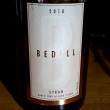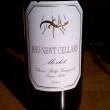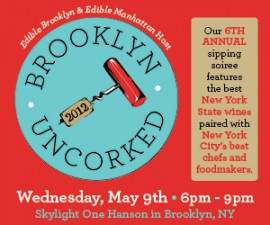Jamesport Vineyards 2007 Sauvignon Blanc Reserve
 When I tasted this wine last week, I started a discussion on Twitter amongst the wine Twitterati about "varietal correctness." Feelings were mixed and a wide range of related topics were brought up, but most agreed that if a wine tastes good, that's the most important thing.
When I tasted this wine last week, I started a discussion on Twitter amongst the wine Twitterati about "varietal correctness." Feelings were mixed and a wide range of related topics were brought up, but most agreed that if a wine tastes good, that's the most important thing.
But, a few wise individuals brought up the idea that when one is pairing wine with a particular food, you should be able to predict, in a general sense, what a wine is going to taste like.
If you're eating fresh Long Island shellfish and open a Sancerre, you're not looking for an oaky, tropical fruit-dominated sauvignon blanc… which is a good segue into this review.
Long Island's style for sauvignon blanc is still developing, but I don't think that this wine, Jamesport Vineyards 2007 Sauvignon Blanc Reserve ($30) is where the future is. At least I hope not.
That's not to say that this wine is awful — far from it. But, it's not what I've come to expect from North Fork sauvignon blanc or Jamesport Vineyard's sauvignon blanc program.
Fermented in puncheons rather than stainless steel, the nose is almost chardonnay-like in its tropical fruit and banana fruit aromas with oak-born spice and light floral qualities.
Medium-bodied and round, the palate tastes much like the nose smells — ripe, tropical with plenty of spice and even a bit of noticeable oak flavors. To be bottled sauvignon blanc, it only has to be 75% that grape. Maybe there is some chardonnay in that other 25%?
There's good acidity, so it's pretty well balanced, it's just not what you'd expect from a Long Island sauvignon blanc. This wine is edging into Fume Blanc territory.
We can argue about the "varietal correctness" here all we want, but if I opened this with a meal, expecting bright citrus and subtle herbs, I'd be disappointed… and would probably open up another bottle of something else, especially given the $30 price point here.
Perhaps people are clamoring for a wine like this one, but I prefer very little-to-no oak in my sauvignon. That's the emerging style on Long Island and one that the region can do very very well.
Producer: Jamesport Vineyards
AVA: North Fork of Long Island
Price: $30
ABV: 13.5%
Rating: (2 out of 5 | Average)

















To begin, there’s something intrinsically wrong with a $30 price tag on a bottle of Long Island Sauvignon Blanc, I don’t care where the juice was aged. And I always felt that Sauvignon Blanc was ultimately a potentially more viable varietal for Long Island winemakers. Somehow over the years, most seemed to have dropped the ball in favor of Chardonnay, which admittedly is sexier and what most people know. The former owners of what is now Vineyard 48 used to turn out excellent Sauvignon Blancs-dry and crisp, citrusy, with a good flinty finish-the perfect quaffer to clams on the half shell, poached lobster or grilled fish-all the great foodstuffs that define the East End of Long Island. Long Island may never match the Marlborough region of New Zealand for great Sauvignon Blanc, but it certainly has the potential to give Sonoma a run for its money.
I felt the same way when I tried Osprey’s Dominion’s Fume Blanc. I don’t like it when they oak sauvignon blanc out west and I’m not a fan of doing it on long island.
If you ask me, abolish all Fume Blancs, it kills the best flavors of the grape.
Ralph: Thanks for the comment. I won’t speak directly to the pricing on this wine. There are higher-priced white wines on the Island. And, sauvignon blanc prices have been steadily rising locally as well…though none of them have cracked the $30 barrier.
The issue with chardonnay vs. sauvignon blanc is a bit more complicated than one might think.
First, believe it or not, people still ask for chardonnay. Winemakers tell me this all the time and I’ve heard people asking for it in tasting rooms.
Secondly, chardonnay is the 2nd most planted grape on Long Island (merlot is 1st). Wineries and vineyards have invested heavily in chardonnay, which is far easier to grow and ripen on Long Island. Ripping those vines out and replacing them with sauvignon blanc (which makes sense from a finished product standpoint) is a large investment that I don’t think many wineries are looking to make right now.
There is no doubt in my mind that the white grape that Long Island does and can do best is sauvignon blanc.
Henry: I tend to agree. I don’t understand the whole Fume Blanc thing. It’s 2009 after all.
What a bummer… Jamesport SB used to be one of my faves, but that wasn’t the Reserve… are they still making a moderately priced steel fermented version, or have they given up on that?
Jay: Fear not, they are actually making three ‘levels’ of sauv blanc these days. An East End, Estate and Reserve. I believe that they all have SOME oak component however.
Barbara and I and a group of friends had the Jamesport Reserve Sauvignon Blanc with dinner recently and loved it. I had made a terrine of pork that was studded with green peppercorns and smoked bacon that paired beautifully with the Jamesport wine.
Long Island producers will hopefully continue to produce bright, fresh, aromatic and unoaked Sauvignon Blanc that shows off the crisp acidity that all of us crave on warm summer days alongside the bounty of our local shellfish.
However, using oak barrels in the production of Sauvignon Blanc is not a crime, and can produce gorgeous, rich and deeply flavored wines that have long aging potential. The Jamesport wine seems to me to be one of those wines.
Winemakers are always looking for an edge to advance their craft. The recently deceased Didier Dagneau pushed hard with Puilly Fume to change the paradigm and elevate the Sauvignon Blanc grape to new heights. Here on Long Island, winemakers have the opportunity to successfully express the varietal characteristics of Sauvignon Blanc in more than one style.
I admire winemakers like Mr.Goerler who push the envelope both in the vineyard and winery. Kudos on another great undertaking.
Lot’s of topics going on in this post. I’ll start with addressing the style of SB that I like best.
Maybe I’m in the minority here, but I’m going to defend the premise of oaking (or rounding out) SB a bit.
First let me say that I was a huge New Zealand SB supporter 10 years ago. However, I think they have taken their fruitiness/grassiness to a new level that makes me think I’m having grapefruit juice rather than wine. I continue to sample NZ SBs, but I haven’t bought one in years.
Next, let me say that I don’t like “fully” oaked SB. My first preference is to have a SB reared in stainless steel and then rounded out a bit by Semillon; Shinn has a great representation of this blend which I first discovered on a visit to Barossa and McClaren Vale where the practice of adding a touch of Semillon to SB is widely practiced. Semillon seems to take some of the raw edge of stainless SB and adds a little depth of flavor.
My next preference would be very lightly oaked SB - say 20% oaked, 80% stainless. This method of light oaking seems to allow the same softening of SB that Semillon offers.
I don’t like the fully oaked SB’s, but even in Cali I think this practice has almost past. Even the bottles labeled Fume Blanc are often not fully reared in oak - - - more often than not over the last 2 years they are partially oaked.
Back to Jamesport - - I haven’t tried this one in particular but from Lenn’s assessment it sounds like this wine may be slanted towards the “fully” oaked style. I would hope there is something on the bottle (maybe the winemakers description on the back) that indicates the style.
In terms of Chardonnay being more sought than SB I think there are 2 simple reasons: 1) beginner drinkers and “happy hour bar drinkers” often prefer Chardonnay as their go to white which really drives up sales and demand, and 2) Chardonnay really goes better with dinner than SB. Really. Think about it. SB goes with a lot of good food (oysters!), but how often do you really have SB-friendly food for dinner with your family? For me, it is the rare occasion when I pop a SB for dinner. I find SB tends to end up as more of an appetizer / hors d’oeuvres wine which is opened to have a glass, not a bottle.
Finally, as for varietal correctness, I think it would be very inappropriate to downgrade a wine because it didn’t seem traditional. The evaluation of a wine should be based on how pleasing it is in and of itself. A critic’s / blogger’s notes can and should make comments about the style or characteristics of the varietal to alert the consumer, but they shouldn’t score it or disparage it based on “correctness”. Just recently I tried a bottle of pinot from Italy and if it had some subtle traditionally pinot characteristics but if I had tasted it blind I likely would not have guessed it to be Pinot Noir. So did this make it bad? Not in any way - - it just made it different. And for $10 a bottle I wound up buying a ½ case of this “different”, “subtle” Pinot.
David Page’s post must have shown up while I was in the middle of typing mine.
For those of you who haven’t discovered Shinn, a few quick notes:
Best SB on Long Island.
Best breakfast (as in the 2nd “B” of the Shinn Farmhouse B&B) anywhere. I’ve had his smoked bacon for breakfast which he described in this post above… it is awesome. Many people often say bacon is “smoked” but you never notice it - - - with David’s housemade smoked bacon, there is no missing the superbly smoked flavor.
Lenn: I know you live close to the North Fork, but you owe yourself…. no, scratch that…. you owe Nina a night at Shinn Farmhouse. You won’t regret it.
David: Thanks for chiming in, as always. I don’t think that anyone is suggesting that using oak in sauvignon blanc is a crime. People (myself included) are just discussing their preference for the bright, fresh sauvignon blanc like your First Fruit (and Ron’s less-oak sauvignon blancs by the way). Hearing what you ate with this wine, I think that would work, but would it work with simply seared scallops over lightly dressed greens? I doubt it and I know that if I were serving such a course, I’d strongly consider sauvignon blanc.
Dave F: That’s one of the things that makes wine so amazing — we all have different preferences. We’re not talking about NZ sauvignon though, this post is more about Long Island style which isn’t nearly as over the top or grassy.
As to chardonnay being better with dinner, I assume you’re talking about no or lightly oaked renditions, yes?
Lenn,
I wasn’t trying to use New Zealand as a comparison for LI SB… I was trying to use it as a reference for a style I don’t like much. I don’t think LI SB approaches their level of grassiness/fruitiness, but I have tried a couple LI bottles that were getting close.
As for Chardonnay with dinner, I’m a big fan of Roanoke’s rendition which is usually 80% stainless and 20% oak. I generally don’t like 100% stainless chardonnay becuase sometimes I think the grape lacks a little substance by itself… though I often like Raphael’s Grand Cru chardonnay which (I believe) is always 100% stainless. In any event, the 100% oaked, 15% alcohol Chardonnay’s are pretty useless for me.
One of the things that came up in the SB tasting at the NY Wine Industry Workshop the other day was that while NZ has gone out of its way to define a very particular style of sauvignon blanc, the consensus among the LI winemakers on the panel is that they’re at that point yet. There are philosophical winemaking differences as well, according to Kareem Massoud (Paumanok), who will sometimes “butt heads” with Chris Tracy (Channing Daughters) about fruit vs. herbaceousness.
I guess one goal of wine appreciation (and wine education) is to get consumers to glean as much information as they can from the label. Things get difficult in the New World where producers are not limited by regional/traditional winemaking rules. What’s the consumer to do? I’m in favor of more winemaking information on wine labels. Think of how much real estate on the label (especially the back label) could be dedicated to things like “Stainless steel fermented”, “MLF/ no MLF”, blending info. For me, the more information the better. Marketing people may not want to confuse the public, but I believe the educated wine consumer (i.e., the one who will care about pairings with food, varietal character, etc.) would like to have that kind of info.
Tom,
I believe we have begun to define our style on Long Island. It’s only been in the past 5-6 years that producers have begun to understand this grape in our region. Our SB wines are quickly becoming our signature white wine, with a combination and balance of tropical, herbal and mineral elements not found in other regions.
Yes NZ has a style that they like to talk about, however in reality that style has changed over the years. NZ SBs are no longer fruit driven - for the most part they’re jalapeno and cat piss driven. Over cropping and the accentuation of aromatics (despite the ripeness of the fruit) has led to many wines that I find completely devoid of any elegance and frankly, undrinkable. I can’t tell you how many people will comment to me that they don’t like NZ SB’s but they love what we’re doing on Long Island. Stay tuned…
To Rich’s comment because I happen to notice it, I cannot stand NZ SB’s no matter how much i’ve tried - but I love LI’s (I specifically happened to have had the 07 Raphael the other night, it was great)..I’m not sure if I had offhand the 07 Estate or Reserve Jamesport SB, but whichever it was, I dug it (I want to say Estate, since I think it was about $17 at Stew’s and the reserve appears to be $30) - it seemed for me personally to be a slight drop-off from the 06, but still tasty.
Tom: I have to agree with Rich on this one that there is most definitely an emerging “Long Island style” in sauvignon blanc. Rich is being modest and diplomatic though — it already IS the signature white for the region (even if all the chardonnay growers might have you think otherwise).
Wineries like Raphael, Shinn, Macari, Jamesport, Channing Daughters and Paumanok are all making quality sauvignon these days and (with some vineyard variation) there is a style that many seem to be going for with at least some of their bottlings. They are fruity, but not overly so (not like hot California). They are herbaceous, but not overly so (like over-the-top NZ). And they are minerally, but not as purely as you see in Sancerre.
I like these wines because they DEFY definition using other regions. They are Long Island, they aren’t like anything else really.